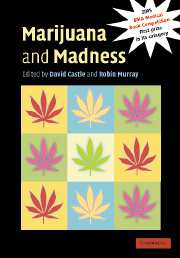Book contents
- Frontmatter
- Contents
- List of contributors
- Foreword
- Preface
- 1 The cannabinoid system: from the point of view of a chemist
- 2 How cannabis works in the brain
- 3 Acute and subacute psychomimetic effects of cannabis in humans
- 4 The association between cannabis use and depression: a review of the evidence
- 5 Cannabis and psychosis proneness
- 6 Is there a specific ‘cannabis psychosis’?
- 7 Cannabis as a potential causal factor in schizophrenia
- 8 Cannabis abuse and the course of schizophrenia
- 9 The endogenous cannabinoid system in schizophrenia
- 10 Cannabinoid ‘model’ psychosis, dopamine–cannabinoid interactions and implications for schizophrenia
- 11 Motives that maintain cannabis use among individuals with psychotic disorders
- 12 Addressing cannabis abuse in people with psychosis
- 13 Residual cognitive effects of long-term cannabis use
- Index
- References
7 - Cannabis as a potential causal factor in schizophrenia
Published online by Cambridge University Press: 07 December 2009
- Frontmatter
- Contents
- List of contributors
- Foreword
- Preface
- 1 The cannabinoid system: from the point of view of a chemist
- 2 How cannabis works in the brain
- 3 Acute and subacute psychomimetic effects of cannabis in humans
- 4 The association between cannabis use and depression: a review of the evidence
- 5 Cannabis and psychosis proneness
- 6 Is there a specific ‘cannabis psychosis’?
- 7 Cannabis as a potential causal factor in schizophrenia
- 8 Cannabis abuse and the course of schizophrenia
- 9 The endogenous cannabinoid system in schizophrenia
- 10 Cannabinoid ‘model’ psychosis, dopamine–cannabinoid interactions and implications for schizophrenia
- 11 Motives that maintain cannabis use among individuals with psychotic disorders
- 12 Addressing cannabis abuse in people with psychosis
- 13 Residual cognitive effects of long-term cannabis use
- Index
- References
Summary
For many decades, the debate about whether cannabis use can cause schizophrenia has remained unresolved. Fifteen years after the publication of the first evidence that cannabis may be a causal risk factor for later schizophrenia, three further epidemiological studies have recently provided supportive evidence. This chapter reviews the evidence that cannabis use can cause schizophrenia, within the framework of established criteria for determining causality.
What is a cause?
The precise definition of what constitutes a cause and the elaboration of criteria for determining causality have a long and contentious history. Epidemiologists have often skirted the controversial topic by referring to ‘risk factors’ or ‘exposures’ rather than ‘causes’. Nevertheless, we do indeed want to find causes.
Rothman and Greenland (1998), in their influential textbook of epidemiology, offered a clear definition of causation:
We can define a cause of a specific disease event as an antecedent event, condition, or characteristic that was necessary for the occurrence of the disease at the moment it occurred, given that other conditions are fixed. In other words, a cause for a disease occurrence is an event, condition or characteristic that preceded that disease occurrence, and without which the disease would either not have occurred at all, or would not have occurred until some later time.
Rothman and Greenland (1998) used pictures of ‘causal pies’ as a device to explain the concept of necessary and sufficient causes (Fig. 7.1).
- Type
- Chapter
- Information
- Marijuana and MadnessPsychiatry and Neurobiology, pp. 101 - 118Publisher: Cambridge University PressPrint publication year: 2004
References
- 8
- Cited by



